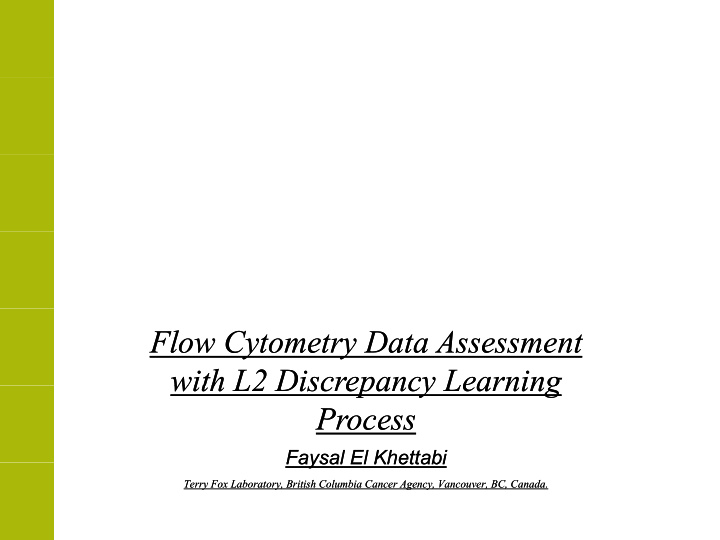



Flow Cytometry Data Assessment Flow Cytometry Data Assessment with L2 Discrepancy Learning with L2 Discrepancy Learning with L2 Discrepancy Learning with L2 Discrepancy Learning Process Process Faysal El Khettabi Faysal El Khettabi Faysal El Khettabi Faysal El Khettabi Terry Fox Laboratory, British Columbia Cancer Agency, Vancouver, BC, Canada. Terry Fox Laboratory, British Columbia Cancer Agency, Vancouver, BC, Canada.
Problem The raw data has N events where each given event is a s-dimensional vector. • Is a given event an insider or an outlier? • How similar or different are two given events? • Without assuming that the events determine a probability measure, can one "emulate" a similar density measure theoretic concept similar density measure-theoretic concept beginning directly with the event s-variables values ? values ? • Can the events be clustered?
An Illustrative Introduction An Illustrative Introduction
L2 Discrepancy p y Local Discrepancy Global Discrepancy Sensitivity Sensitivity
SENSITIVITY
INTERPRETATION
Kernel Density Estimation vs. Discrepanc Sensiti it Discrepancy Sensitivity
Discrepancy Cytometry Analytics (DCA) (Examining raw data with the purpose of drawing conclusions about the events.) The root mean square expectation of L2 discrepancy(RMSELD) value for all random sequence The root mean square expectation of L2 discrepancy(RMSELD) value for all random sequence with N events is equal to: SQRT(12^ with N events is equal to: SQRT(12^-s*( 2^s with N events is equal to: SQRT(12^ s*( 2^s with N events is equal to: SQRT(12^ s*( 2^s 1)/N) s*( 2^s - -1)/N). 1)/N) 1)/N). RF, Randomness Fit = (L2 discrepancy Raw Data) / RMSELD RF, Randomness Fit = (L2 discrepancy Raw Data) / RMSELD (if RF is close to one, the raw data is uniformly random.) (if RF is close to one, the raw data is uniformly random.) PO, Proportion of Outlier events. PO, Proportion of Outlier events. PI, Proportion of Insider events. PI, Proportion of Insider events. , , p p LA, Logarithmic Average of (1+Sn) (equivalent to Variance of the LA, Logarithmic Average of (1+Sn) (equivalent to Variance of the Sensitivity). Sensitivity). XI, square sensitivity of outlier events / square sensitivity of insider XI XI XI, square sensitivity of outlier events / square sensitivity of insider square sensitivity of outlier events / square sensitivity of insider square sensitivity of outlier events / square sensitivity of insider events. events. These parameters are intrinsic properties of the events distribution These parameters are intrinsic properties of the events distribution These parameters are intrinsic properties of the events distribution. These parameters are intrinsic properties of the events distribution.
Quality Assessemnt (CFSE data Set) (CFSE data Set) (Sample 13 has an issue)
Density Emulation NDD with 12 variables NDD with 12 variables
Discrepancy K means p y K-Means is a least-squares partitioning method. Allowing users to divide a collection of objects into K groups. ll ti f bj t i t K The initial centroid guesses and their numbers are very hard to figure out for any given data. given data K-Means method based on L2 Discrepancy used the sensitivity to define the most insiders as centroids the algorithm iterate between the following simple steps: insiders as centroids, the algorithm iterate between the following simple steps: Step 1, assign all events to the set R=X Step 2 pick up the event x {n} with the maximum senstivity in R Step 2, pick up the event, x_{n}, with the maximum senstivity in R. Step 3, C={all events close to x_{n} , accordingly to a given criteria} Step 5, set R=R-C, go to step 2.
Discrepancy Kmeans Kmeans
CONCLUSION • We developed a L2 discrepancy learning process to assess how flow cytometry data are spatially distributed. • This discrepancy learning process is able to recover the spatial distribution where the individual events are either clumped or scarce. • It is simple to numerically implement and provides a quantitative level of information to track the most outliers information to track the most outliers . • We applied the L2 discrepancy learning process to K-Means clustering method. The discrepancy K-Means does not require the estimation of the number of clusters or other parameters and the L2 discrepancy learning number of clusters or other parameters and the L2 discrepancy learning process defines the means/modes as insiders automatically.
SUPPORT The statistical and bioinformatics approaches to the classification of clinical lymphoma and leukemia data (Canadian Cancer Society grant 700374) t 700374) The statistical and computational analysis of flow cytometry data p y y y (NIH/NIBIB grant EB008400).
Recommend
More recommend